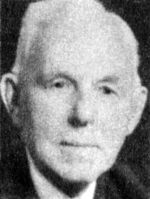
John Thomas Haig
Encyclopedia

Queen's Privy Council for Canada
The Queen's Privy Council for Canada ), sometimes called Her Majesty's Privy Council for Canada or simply the Privy Council, is the full group of personal consultants to the monarch of Canada on state and constitutional affairs, though responsible government requires the sovereign or her viceroy,...
(December 15, 1877 – October 23, 1962) was a politician in Manitoba
Manitoba
Manitoba is a Canadian prairie province with an area of . The province has over 110,000 lakes and has a largely continental climate because of its flat topography. Agriculture, mostly concentrated in the fertile southern and western parts of the province, is vital to the province's economy; other...
, Canada
Canada
Canada is a North American country consisting of ten provinces and three territories. Located in the northern part of the continent, it extends from the Atlantic Ocean in the east to the Pacific Ocean in the west, and northward into the Arctic Ocean...
. He served as parliamentary leader of the Manitoba Conservative Party
Progressive Conservative Party of Manitoba
The Progressive Conservative Party of Manitoba is the only right wing political party in Manitoba, Canada. It is also the official opposition party in the Legislative Assembly of Manitoba.-Origins and early years:...
in 1921-22.
Born in Colborne, Ontario
Ontario
Ontario is a province of Canada, located in east-central Canada. It is Canada's most populous province and second largest in total area. It is home to the nation's most populous city, Toronto, and the nation's capital, Ottawa....
, Haig received his BA
Bachelor of Arts
A Bachelor of Arts , from the Latin artium baccalaureus, is a bachelor's degree awarded for an undergraduate course or program in either the liberal arts, the sciences, or both...
from the University of Manitoba
University of Manitoba
The University of Manitoba , in Winnipeg, Manitoba, Canada, is the largest university in the province of Manitoba. It is Manitoba's most comprehensive and only research-intensive post-secondary educational institution. It was founded in 1877, making it Western Canada’s first university. It placed...
and worked as a Barrister-at-law. He was elected to the Winnipeg Public School Board in 1908, and continued to hold this position after entering provincial politics.
Haig was first elected to the Legislative Assembly of Manitoba
Legislative Assembly of Manitoba
The Legislative Assembly of Manitoba and the lieutenant governor form the Legislature of Manitoba, the legislature of the Canadian province of Manitoba. Fifty-seven members are elected to this assembly in provincial general elections, all in single-member constituencies with first-past-the-post...
for Assiniboia in 1914. He was soundly defeated in the Liberal
Manitoba Liberal Party
The Manitoba Liberal Party is a political party in Manitoba, Canada. Its roots can be traced to the late nineteenth-century, following the province's creation in 1870.-Origins and early development :...
landslide of 1915, but returned to the legislature in 1920 at the head of the Conservative Party list in Winnipeg. (Winnipeg elections were determined by a form of proportional representation
Proportional representation
Proportional representation is a concept in voting systems used to elect an assembly or council. PR means that the number of seats won by a party or group of candidates is proportionate to the number of votes received. For example, under a PR voting system if 30% of voters support a particular...
at this time.)
Conservative leader R.G. Willis was unable to win a seat in the 1920 election, and Haig was called to lead the eight-member caucus in parliament. He ran for the party's leadership in April 1922, but was defeated by Major Fawcett Taylor
Fawcett G. Taylor
Fawcett Gowler Taylor was a Manitoba politician, and was the leader of that province's Conservative Party from 1922 to 1933....
.
Haig was re-elected to the legislature in 1922, 1927 and 1932, and remained an important voice for the party.
In August 1935, he was appointed to the Canadian Senate
Canadian Senate
The Senate of Canada is a component of the Parliament of Canada, along with the House of Commons, and the monarch . The Senate consists of 105 members appointed by the governor general on the advice of the prime minister...
on the recommendation of Prime Minister R.B. Bennett. From 1945 until 1957, Haig was Leader of the Opposition in the Senate
Leader of the Opposition in the Senate (Canada)
In Canada, the Leader of the Official Opposition in the Senate is the leader of the senate caucus of the largest party in the Senate that is not in government. The position is appointed by the leader of the party that forms the opposition in the Senate...
for the Progressive Conservative Party
Progressive Conservative Party of Canada
The Progressive Conservative Party of Canada was a Canadian political party with a centre-right stance on economic issues and, after the 1970s, a centrist stance on social issues....
. After the 1957 federal election
Canadian federal election, 1957
The Canadian federal election of 1957 was held June 10, 1957, to select the 265 members of the House of Commons of Canada. In one of the great upsets in Canadian political history, the Progressive Conservative Party , led by John Diefenbaker, brought an end to 22 years of Liberal rule, as the...
, Haig joined the Cabinet of John George Diefenbaker, serving as Minister without portfolio
Minister without Portfolio
A minister without portfolio is either a government minister with no specific responsibilities or a minister that does not head a particular ministry...
and Leader of the Government in the Senate
Leader of the Government in the Senate (Canada)
The Leader of the Government in the Senate is a Canadian cabinet minister who leads the government side in the Canadian Senate and is chiefly responsible for promoting and defending the government's program in the Upper House. The government leader's counterpart on the Opposition benches is the...
until May 11, 1958.
He retired from the Senate on January 17, 1962.

